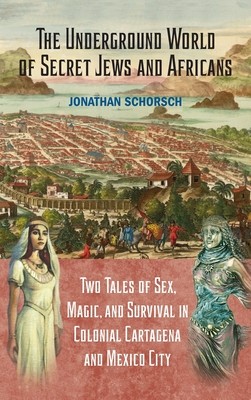
- We will send in 10–14 business days.
- Author: Jonathan Schorsch
- Publisher: Markus Wiener Publishers
- Year: 2021
- Pages: 202
- ISBN-10: 1558769528
- ISBN-13: 9781558769526
- Format: 15.2 x 22.9 x 1.6 cm, kieti viršeliai
- Language: English
- SAVE -10% with code: EXTRA
The Underground World of Secret Jews and Africans (e-book) (used book) | bookbook.eu
Reviews
Description
Spanish colonial society was divided into a caste system based on race and religion. Slaves comprised the lowest caste, leading some to seek power through African magic, while children of Jewish fathers and African women tried to gain social status by embracing Judaism-but in the process they risked retribution from the Spanish Inquisition, whose tribunals zealously prosecuted the perceived threat to the colonies from multicultural witchcraft and from alleged secret Jews.
These two tales illustrate the perils tied to religious identity and practice in the colonies. One, set in 17th-century Cartagena des Ãndias, features a biracial surgeon who was famed for his magic powers. His lover, jealous of the other women in his life, reported him to the Inquisition. To bargain for his freedom, he denounced his wealthier colleague for secretly practicing Judaism. The colleague was arrested, confessed under torture, and died in prison from his wounds.
The second story involves Esperanza RodrÃguez, a biracial Mexican woman tried by the Inquisition in the 1640s for secretly practicing Judaism. In Seville, RodrÃguez had been a slave of a New Christian (converted Jewish) woman, who introduced her to Judaism before freeing her. RodrÃguez accepted Judaism in order to close the social gap that separated her from her former owner. But she was eventually tortured into confessing her religion, and she died in prison.
EXTRA 10 % discount with code: EXTRA
The promotion ends in 22d.22:06:28
The discount code is valid when purchasing from 10 €. Discounts do not stack.
- Author: Jonathan Schorsch
- Publisher: Markus Wiener Publishers
- Year: 2021
- Pages: 202
- ISBN-10: 1558769528
- ISBN-13: 9781558769526
- Format: 15.2 x 22.9 x 1.6 cm, kieti viršeliai
- Language: English English
Spanish colonial society was divided into a caste system based on race and religion. Slaves comprised the lowest caste, leading some to seek power through African magic, while children of Jewish fathers and African women tried to gain social status by embracing Judaism-but in the process they risked retribution from the Spanish Inquisition, whose tribunals zealously prosecuted the perceived threat to the colonies from multicultural witchcraft and from alleged secret Jews.
These two tales illustrate the perils tied to religious identity and practice in the colonies. One, set in 17th-century Cartagena des Ãndias, features a biracial surgeon who was famed for his magic powers. His lover, jealous of the other women in his life, reported him to the Inquisition. To bargain for his freedom, he denounced his wealthier colleague for secretly practicing Judaism. The colleague was arrested, confessed under torture, and died in prison from his wounds.
The second story involves Esperanza RodrÃguez, a biracial Mexican woman tried by the Inquisition in the 1640s for secretly practicing Judaism. In Seville, RodrÃguez had been a slave of a New Christian (converted Jewish) woman, who introduced her to Judaism before freeing her. RodrÃguez accepted Judaism in order to close the social gap that separated her from her former owner. But she was eventually tortured into confessing her religion, and she died in prison.


Reviews